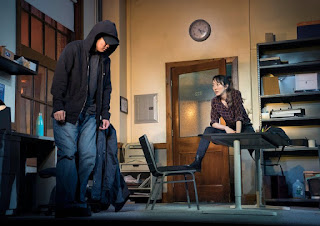Theater: Office Hour dramatically addresses campus violence and depression
Office Hour
Written by Julia Cho
Directed by Neel Keller
Starring Sue Jean Kim, Ki Hong Lee
New York Public Theater
December 3, 2017
Gina, his newest teacher, has similar fears but wonders if
some of the pressure and prejudice she experienced as an Asian student might be
partly to blame for Dennis’ troubles. Sue Jean Kim is excellent in portraying
Gina’s simultaneous maternalism, fear, and frustration with the sullen Dennis
(an equally excellent Ki Hong Lee) as she gradually gets Dennis to speak a few
words, then shout, then share some of his life story and overwhelming lack of self-worth
at the core of his behavior.
But the others’ fears are never made irrelevant—for
example Dennis does have a gun, which
he brings to school in his backpack (not so strange in our culture where Texas
allowed students just such a right, and some school districts are considering
arming their teachers). The one-hour office hours session covers a lot of
ground in current educational controversy and adolescent psychology. What degree
of personal intimacy or touching is appropriate for a teacher? What is the
teacher’s responsibility to the individual student vs. to all students, who may
be disturbed by a single student’s behavior or simply be intolerant of him/her?
How much should a teacher extrapolate their own cultural history/baggage in
dealing with a student? These are questions that all teachers, physicians,
therapists must learn to address. An interesting technique used by the
playwright to communicate Gina’s anxiety is a device borrowed from film, in
which some of her worst fears (a shooting, a suicide) play out visibly to the
audience as an alternative plot; then we time loop back to the real office
interaction and go on. This device is surprisingly effective, enhanced by the
natural, unmelodramatic acting of the two principal actors. It goes just a bit
too far once, when we are surrounded by gunfire in order to evoke the worst of
the teen shooting episodes (e.g. Columbine).
Based on my own as an educator, I thought the play presented
a thoughtful, well written discussion of the conflicting roles of the teacher. But it also educated the audience about some
of the unique prejudice faced by Asian immigrants and their children, who often
struggle to fit in while honoring their parents’ traditions. The director kept
things moving, the playwright avoided preachiness, and the fine acting led to a
thought-provoking and dramatic 90 minutes.
Note: This was the fourth play I have seen at the New York
Public Theater, a now-venerable institution in the East Village. It was founded
by Joe Papp in the 1950’s as a “forum for ideas and inclusion” and has some
very distinctive culture. For example, the curtain time of each play is delayed
a bit as empty seats are filled by playgoers who line up for free tickets,
making many plays available to students and those with limited funds. The
venues are intimate, allowing a very up-close interaction with the actors. Prices are low by NY standards. The mission
statement reads that theater is “an essential cultural force with the power to
lead and frame dialogue on some of the most important issues of our day”. This
means they take lots of risks on new playwrights, esp. those who depict
populations underrepresented in most theaters. I think they are very successful
in this. The plays are well played, produced, and directed, even if they are sometimes
uneven in writing quality. The low cost means that the audience will take some
risks on seeing plays by lesser known playwrights. Yes, that means the
occasional clunker (see Tiny Beautiful
Things), but also excellent shows like Office
Hour and Oedipus el Rey.

Comments
Post a Comment